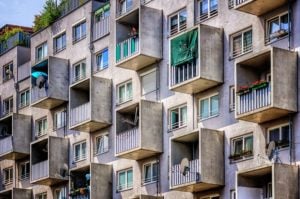How the New EWS1 Agreement Offers Hope to Cladding Mortgage Prisoners

After the Grenfell fire tragedy in June 2017, measures to improve fire safety in high-rise buildings were introduced by the government. Although necessary, the crackdown on potentially dangerous cladding has left thousands of flat owners in near-unsellable homes.
The regulations brought in that summer stated that mortgages could not be approved for flats in buildings over 18 metres tall unless the property has passed an External Wall Fire Review (EWS1) survey. The main problem here is that these forms are tricky to obtain, and as a result, many flat owners have found it difficult to sell or remortgage their property.
But it looks like there’s light at the end of the tunnel for those caught up in the cladding scandal. New measures unveiled by the UK Government in conjunction with the Royal Institution of Chartered Surveyors (RICS) could deliver the key to their mortgage prisons.
Important
Have you had a mortgage application rejected because of EWS1 cladding issues? Get in touch and we’ll introduce you to an expert for specialist advice. The brokers we work with help people in these circumstances every day and know exactly which lenders are willing to take a flexible approach to those who’ve been affected by the cladding scandal
Why is it so difficult to get a mortgage on a flat with cladding?
Because these properties usually need an EWS1 survey conducted on them and they’re very difficult to come by. What’s more, many flat owners who have managed to get the checks carried out have had issues getting the recommended repair work completed.
Here are some of the most common issues flat owners who are looking to sell or refinance have encountered around EWS1 reports and cladding-related issues…
Unable to get a survey carried out
A cladding report for a mortgage application is difficult to come by because of a skills shortage in the industry. At the time of writing, just 291 people are qualified to carry out the tests needed for an EWS1 form and they’ve been rather busy since Grenfell.
Confusion over which properties need an EWS1 report
Some mortgage lenders have reportedly turned down purchase and remortgage applications on flats because they wrongly believed an EWS1 report was called for. There has been some confusion over which type of flats need a certificate and which ones are exempt.
EWS1 certificates are not necessary if the building in question is under 18 metres high or doesn’t have cladding, and the new measures aim to set this in stone.
Disputes over who foots the cladding bill
Some homeowners who’ve had the cladding checks carried out and been alerted to the presence of potentially unsafe material have become embroiled in bitter disputes about who should be responsible for rectifying the problem. Works to repair and replace cladding can be costly, and many leaseholders are claiming it shouldn’t be them who picks up the bill.

They firmly believe the responsibility lies with the freeholders, who actually own the property, though some of them are pointing the finger at the building firms who installed the cladding. But builders are claiming their work was in line with government guidelines at the time, and therefore the doorstep of 10 Downing Street is where the buck should stop.
At the time of writing, it’s estimated that 155 out of 455 high-rise buildings with similar cladding to Grenfell are yet to undergo the recommended renovations, and it’s easy to see why considering that, in many cases, nobody wants to take responsibility for the bill.
A lack of available mortgage lenders
Even if their high-rise property has passed an EWS1 assessment, some flat owners have still found it difficult to find a lender willing to offer them a mortgage or a remortgage. That’s because not all lenders offer finance for this property type.
The ones which do almost exclusively ask for an EWS1 certificate, regardless of whether a surveyor has assessed the property. And, of course, all of the other issues discussed above have a bearing on the mortgageability of high-rise flats and properties with cladding.
This has left mortgage lenders in a tricky situation, and the mortgage prisoners caught up in the dispute in an even trickier one. Most surveyors won’t carry out a valuation on a property with cladding unless an EWS1 form is produced, but they haven’t been easy to come by.
How will the new measures address this?
The new measures agreed by the government and RICS, in conjunction with UK Finance and the Building Societies Associations (BSA), clarify that flat owners in buildings without cladding don’t need an EWS1 form to sell or remortgage their property.
This aims to address the confusion which has seen some mortgage lenders reject finance applications for flats without cladding, wrongly believing that an EWS1 report was needed. It is estimated that this will pave the way for almost 450,000 flat owners to sell or remortgage.
The government has also pledged to invest more than £700,000 to train 2,000 additional building assessors in EWS1 reviews for properties that do need them.
Plans for a new industry-wide valuation model
RICS have also been leading a cross-industry working group to consider best practice in the reporting and valuation of tall buildings in the secured lending sector. The new model sets out an industry-wide process for valuers, lenders, building owners and fire safety experts in the valuation of high-rise properties over 18 metres with potentially combustible materials.
This aims to remove obstacles that have been stopping high-rise flat owners from remortgaging or selling their homes, and speed up the lending process for these properties.
What to do if you’ve had a mortgage rejected because of cladding
First off, first out exactly what the issue is. If you were unable to get your property valued because it doesn’t have an EWS1 certificate, double-check whether it actually needs one under the latest guidelines. It might be the case that your flat is now exempt.
If you can’t get a mortgage because your property failed an EWS1 assessment or still needs to undergo one, this is a more complicated situation, but in light of the government’s pledge to train up more assessors and RICS outlining plans for an industry-wide valuation model for high-rise flats, there are reasons to be hopeful that your situation could improve.

Of course, the issues around cladding and mortgages are unlikely to be anything close to resolved until lenders and valuers are in a position to take the new measures fully on board, though there are early signs of criteria for mortgages on these properties being relaxed.
Are there any lenders for cladding properties without an EWS1 report?
At the time of writing, one specialist mortgage lender is willing to consider offering finance for flats with cladding that don’t have an EWS1 certificate, on the condition that a surveyor has assessed the property and decided that a report is not necessary.
It’s worth talking to a mortgage broker if you’ve had a mortgage or remortgage application rejected due to cladding as they will be able to tell you what your options are. It might be possible that a specialist lender will consider your application on a case-by-case basis, or you’re advised to wait and see whether the new measures start to bear fruit.
Will these measures do the trick?
Housing secretary Robert Jenrick had pledged to work with mortgage lenders to ensure that some of the issues they’re currently facing around flats with cladding are resolved as soon as possible, namely the lack of clarity around which properties actually need an EWS1 report and the skills shortage that’s creating delays in having the checks carried out.
“I welcome the support we have received from RICS and industry to resolve this matter and will be working urgently with lenders to resolve these challenges, ensuring that EWS1 forms are requested only where absolutely necessary and that the number of surveyors able to complete them is increased urgently to meet demand,” he said in a statement.
The industry reacts
Reaction to the new measures from the mortgage and property industries has generally been positive, but some professionals within the section believe they don’t go far enough.
Chris Kenny, a mortgage and protection advisor with Finance Advice Centre, said that the extra clarity about which properties need an EWS1 report and the efforts to train up more assessors are a step in the right direction, but he also points out that won’t help flat owners who need cladding repairs carried out and have no way of funding them.
“The agreement is only for buildings above 18m where there’s no cladding. Great news for those in such a building, but there are still far more buildings in the country that do have the cladding, so the agreement still only helps a minority of people at this stage,” he said.
“The news about training for additional surveyors to sign off EWS1 forms is positive however I’m concerned that the quantity of available surveyors isn’t the problem. The feedback I have been getting is that since Grenfel, many surveyors simply aren’t willing to risk signing off EWS1 forms. If the external cladding/skin is made of a risky or combustible material you could have an endless supply of EWS1 certified surveyors but it still won’t get signed off.”

Further action needed
Industry consultant Phil Whitehouse has also welcomed the news, although he believes further action is needed, particularly to resolve the issue of who foots the cladding bill.
“It should be widely welcomed that initial work done by the government and RICS, together with lenders and trade bodies, has helped in the journey to start to clarify the confusion about the use of EWS1 surveys and the impact this has had on the housing market,” he told Online Mortgage Advisor.
“However, this work is only the very start of a solution to tackle the massive problem that still exists and will take many years to sort out due to the complexities caused by the many parties involved and their respective interests and potential financial liabilities.”
Light at the end of the tunnel?
It should be pointed out that, at this stage, mortgage lenders are under no obligation to take any of these measures on board. Offering finance for risky high-rise properties is done at their discretion and the number of lenders for high-rise properties is already slim. That said, any measures to help resolve the cladding scandal can only be seen as a good start.
Pete Mugleston, our managing director and UK mortgage expert, said: “Resolving the many issues the cladding scandal has created for mortgages on high-rise flats was always going to be a lengthy process, but the new measures already agreed by the government and RICS are promising and will offer a potential lifeline to some of those affected.
“Looking further forward, the promise of more trained EWS1 assessors and a potential industry-wide valuation model for these properties will continue to unlock this corner of the market. Additional support is needed to help those whose properties have failed EWS1 assessments, so here’s hoping the positive momentum we’re seeing around this will lead to further change.”
While these new guidelines have the potential to free some of the mortgage prisoners the cladding scandal has created, fully resolving the issue could hinge on the implementation of the RICS-led valuation model, further support from the government and the mortgage industry’s willingness to take on board all of the measures that spin out of this.
